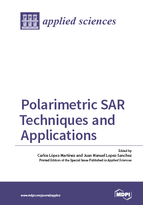Polarimetric SAR Techniques and Applications
A special issue of Applied Sciences (ISSN 2076-3417). This special issue belongs to the section "Computing and Artificial Intelligence".
Deadline for manuscript submissions: closed (15 April 2017) | Viewed by 60396
Special Issue Editors
Interests: remote sensing; synthetic aperture radar; polarimetry; interferometry; signal and image processing; quantitative information retrieval
Special Issues, Collections and Topics in MDPI journals
Interests: radar polarimetry; interferometry; polarimetric SAR interferometry; agriculture; geophysics
Special Issues, Collections and Topics in MDPI journals
Special Issue Information
Dear Colleagues,
During the last two decades, an increasing number of spaceborne Synthetic Aperture Radar (SAR) systems have been equipped with polarimetric capabilities, as for instance, ALOS and ALOS-2, Radarsat-2, TerraSAR-X, Envisat-ASAR, Sentinel-1a/b, etc. Future planned mission will still present this type of diversity where some examples are RCM, SAOCOM and SAOCOM-CS, Cosmo-Skymed 2nd generation or PAZ. In addition, an increasing number of airborne and even ground-based SAR systems are adopting polarimetric capabilities.
As it has been demonstrated extensively in the past, polarimetry makes it possible to have sensitivity to the structural and geometric properties of the targets under observation, allowing a more accurate identification and classification than non-polarimetric systems. Then, polarimetry has made possible new applications, especially in quantitative extraction of new bio and geophysical parameters. It has been also shown that the combination of polarimetry and interferometry makes it possible an unprecedented sensitivity to the vertical structure of semi-transparent media, such as crops or forests.
Consequently, SAR polarimetry has been an active and fruitful field of research in Earth observation. Besides the development of applications, many researchers have also focused their efforts in theoretical aspects or physical modelling to make SAR polarimetry a truly operative remote sensing technique.
The aim of this Special Issue is to present the state of the art in SAR Polarimetry, ranging from theory and physical modeling to final applications, but also to show the current and futures challenges of SAR Polarimetry with the availability of new sources of data. Therefore, this Special Issue puts also the emphasis on studies for the exploitation of data provided by the new polarimetric space borne SAR sensors, which include additional frequency bands, interferometric capability, enlarged spatial coverage, high spatial resolution and/or shorter revisit times.
This Special Issue of the journal Applied Sciences, “Polarimetric SAR Techniques and Applications”, aims to attract novel contributions covering a wide range of aspects related to PolSAR, from theory and techniques to applications. Our topics of interest include, but are not limited to:
• Fundamental theory of SAR polarimetry
• New processing techniques for PolSAR data: calibration, filtering, classification, etc.
• New or improved target decompositions theorems for PolSAR data,
• Operational or future applications of PolSAR data,
• Combination of PolSAR with interferometry, differential interferometry or other sources of diversity,
• Time series exploitation and change detection based on PolSAR data,
• Data fusion among PolSAR sensors or with other type of data.
Prof. Juan M. Lopez-Sanchez
Prof. Carlos Lopez-Martinez
Guest Editors
Manuscript Submission Information
Manuscripts should be submitted online at www.mdpi.com by registering and logging in to this website. Once you are registered, click here to go to the submission form. Manuscripts can be submitted until the deadline. All submissions that pass pre-check are peer-reviewed. Accepted papers will be published continuously in the journal (as soon as accepted) and will be listed together on the special issue website. Research articles, review articles as well as short communications are invited. For planned papers, a title and short abstract (about 100 words) can be sent to the Editorial Office for announcement on this website.
Submitted manuscripts should not have been published previously, nor be under consideration for publication elsewhere (except conference proceedings papers). All manuscripts are thoroughly refereed through a single-blind peer-review process. A guide for authors and other relevant information for submission of manuscripts is available on the Instructions for Authors page. Applied Sciences is an international peer-reviewed open access semimonthly journal published by MDPI.
Please visit the Instructions for Authors page before submitting a manuscript. The Article Processing Charge (APC) for publication in this open access journal is 2400 CHF (Swiss Francs). Submitted papers should be well formatted and use good English. Authors may use MDPI's English editing service prior to publication or during author revisions.






